More than just a canal
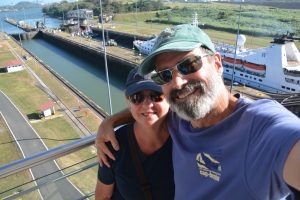
When in Panama you have to do the canal – what an amazing experience to watch the ships pass through the locks!
For most people when they hear the word Panama the first thing they think of is canal. And the second thing they think of is…well…good question. Panama hats, perhaps? Julie and I had come to Panama for much more than just the canal, although we were looking forward to that. For us Panama marked the end of our Central American adventure and also one of the most expensive, risky and stressful moments of our whole trip – putting Tramp on an open cargo ship and picking him up in Colombia, South America. But before that we have Panama.
Panama’s international profile is most certainly attached to the canal but also to the serious corruption, drugs and social unrest of the 1970’s and 80’s during the reign of their bad-boy leader Noriega. But those days are gone and today Panama is the fastest growing economy in Central America, democratic, progressive and even though they may have started behind some of their neighbours they are doing their best to catch up.
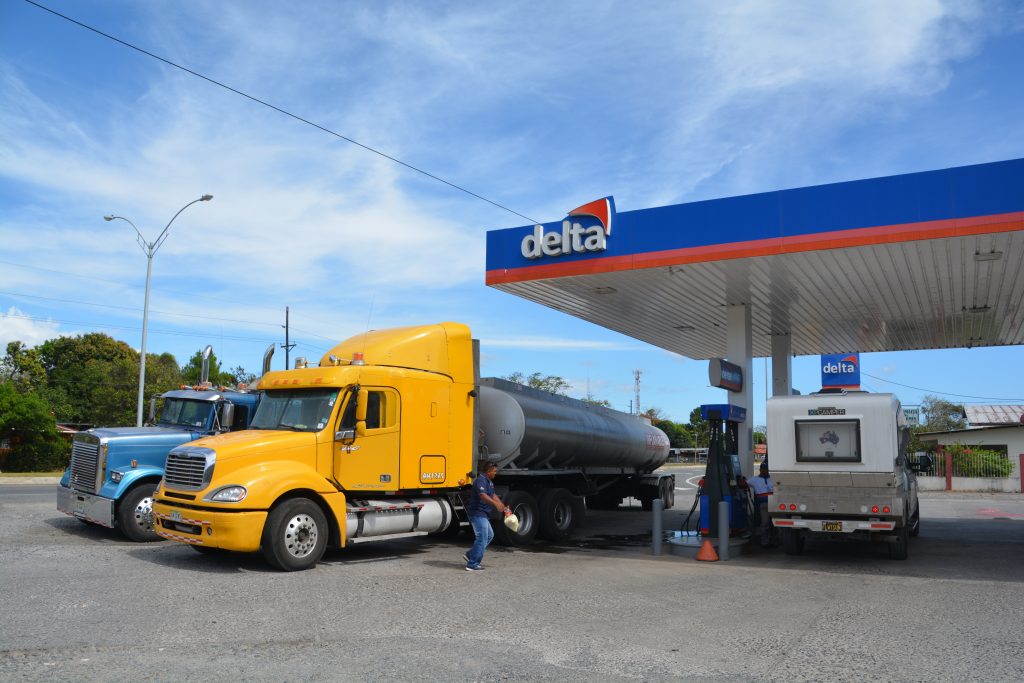
The cost of petrol jumps up and down depending on what country you are in. Panama is much cheaper than Costa Rica so Tramp waited to cross the border before topping up.
It took us two hours to pass out of Costa Rica and into Panama after more chaos at the border, more queues, fees, stamps, inspections and another ridiculous fumigation. And immediately Panama was a surprise. The Pan-American highway, which we planned to follow all the way to Panama City, was a beautiful brand new four lane divided highway, as good as any you would see in the world. And the homes along the side of the road were modest, that’s for sure, but they were, clean, tidy and often a satellite dish on top and a car parked out front.
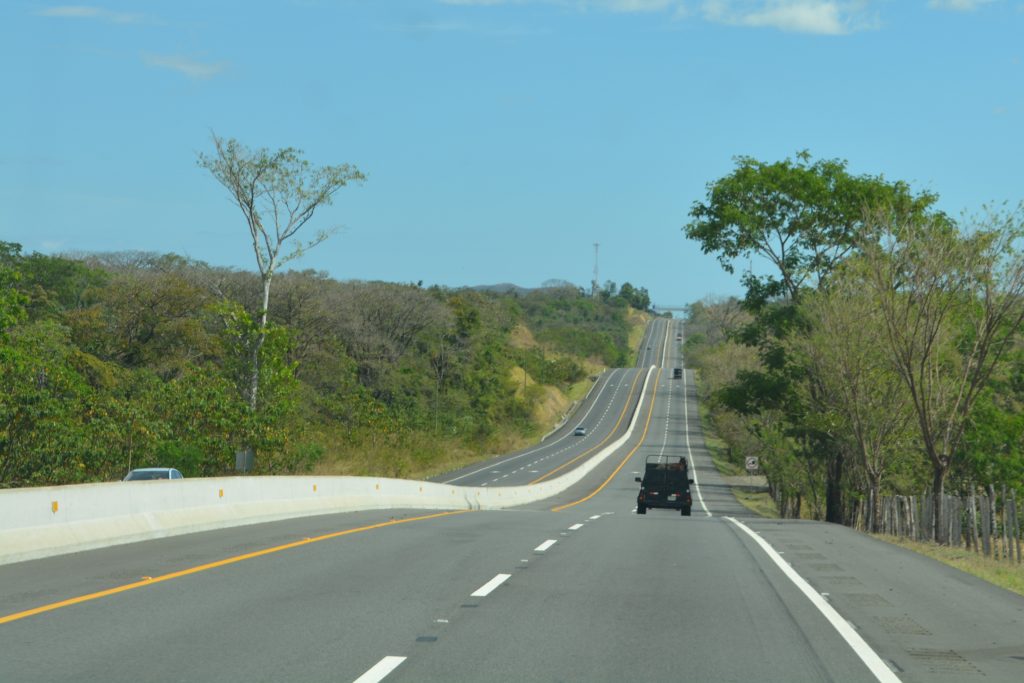
Wow – who would have expected this? The Pan-American Highway through Panama is absolutely first class and almost no traffic.
We stopped in Panama’s second largest city, David, to pick up supplies but were impressed by its very western world appearance. All the fast food chains were there, large air-conditioned shopping malls, wide roads, nice cars and sensible drivers. At first glance Panama was at the Costa Rican standard and quite a few steps ahead of their other northern neighbours.
We camped our first night at the back of a large petrol station, one of our specialties, with some young Argentinian motorcycle riders who were on a journey similar to ours. They generously shared with us mate (pronounced mat – a), an Argentinian tea that has very traditional rules about how to drink it, while we chatted about our respective travels. The next day all headed for the country’s capital, Panama City. The highway, which acts as the backbone of this narrow and mountainous country, was in good condition and we enjoyed the drive through patches of jungle, modest commercial development, residential areas and tropical agriculture such as bananas, sugarcane, rubber trees and mangoes.
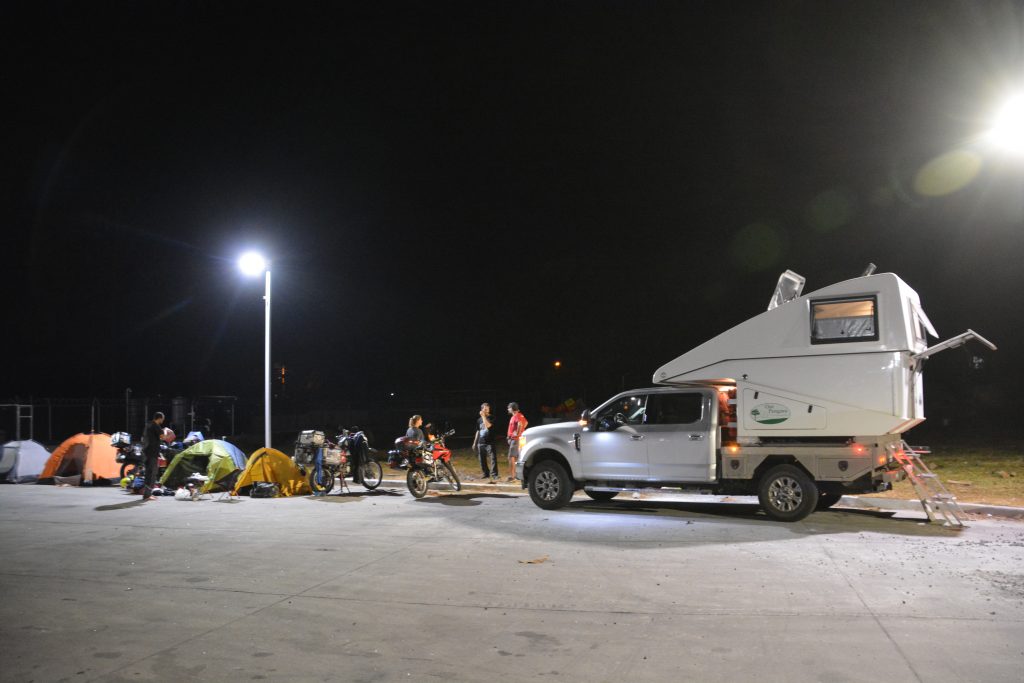
Our first night in Panama was in a large truck stop with some delightful Argentinian bikers – great young people who we would come to know better over the next week or so
Panama City is the most cosmopolitan and international city of Central America, largely due to it being a centre for international banking, finance and investment. The tall glass skyscrapers of the downtown area contrasted with a few of the more slummy suburbs we saw on our way into town. But crossing the majestic Bridge of the Americas, which essentially spans the open mouth of the Panama Canal on the Pacific side, brought us down into the middle of this bustling city.
Our mission the following day was to get Tramp inspected and cleared for his sea voyage to South America, a tedious and somewhat stressful bureaucratic task that all overlanders must do. We found the obscure and run-down building that we’ll visit the following day for inspection and then drove out to the Panama Canal Visitors Centre which is located at the Miraflores Lock, one of the three massive locks that control the water level of the Panama Canal.
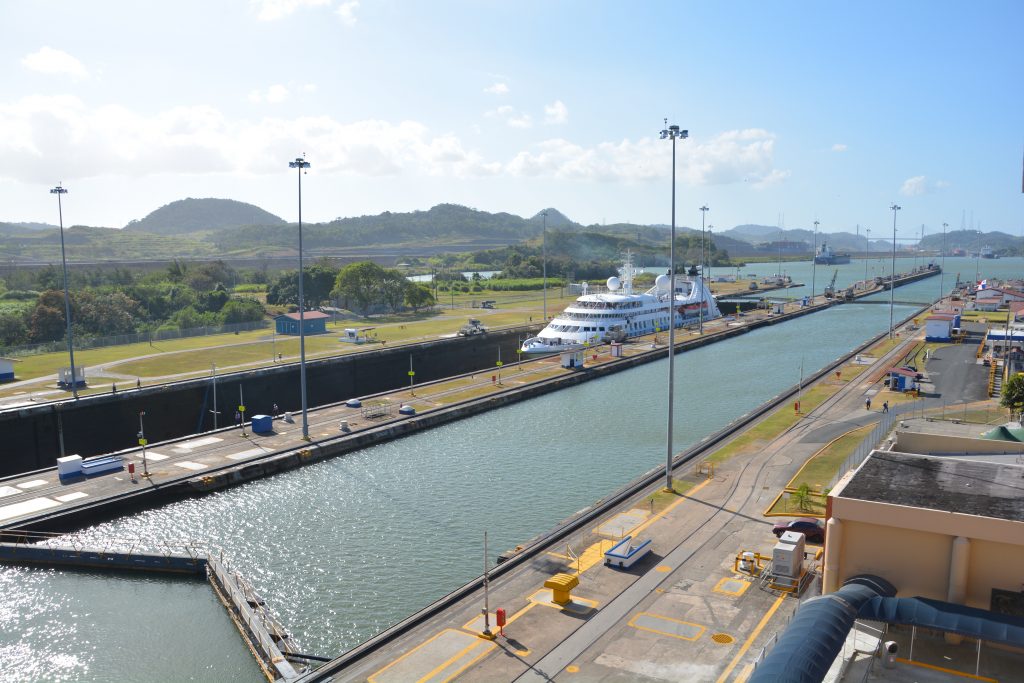
Short explanation – the ship sails into the full lock, the doors close, the water drains out, the doors open and the ship moves forward to the next lock – simple!
The Canal’s history also serves as a snapshot of the country’s history. The French first tried to build a canal in the 1880’s but underestimated the size and complexity of the task and also suffered thousands of deaths from their imported labour force due to yellow fever and malaria. The Americans came in 1903 just after the Panamanians declared independence from Colombia. The American saw it as a commercial project and completed the canal in 1914, an extraordinary accomplishment and still one of the great engineering feats of mankind. They finally handed over the canal to the Panamanian government in 1999.

The Panama Canal was super cool and from the four story visitor’s centre at the Miraflores Locks we were able to watch the whole process of a few ships passing through
Today the canal runs for 80 km from the Pacific Ocean to the Atlantic Ocean, the three giant locks lift ships 26 metres (about 80 feet) so they can travel across the huge man-made lake before dropping back down into the other side. The locks fill and release millions of gallons of water for each ship through a series of massive gravity-fed underground pipes and it takes a ship about 8-10 hours to travel from one ocean to another. Fees range from $800 for a small privately-owned yacht to over $200,000 for the largest container ship. Over 13,000 ships per year make the journey.
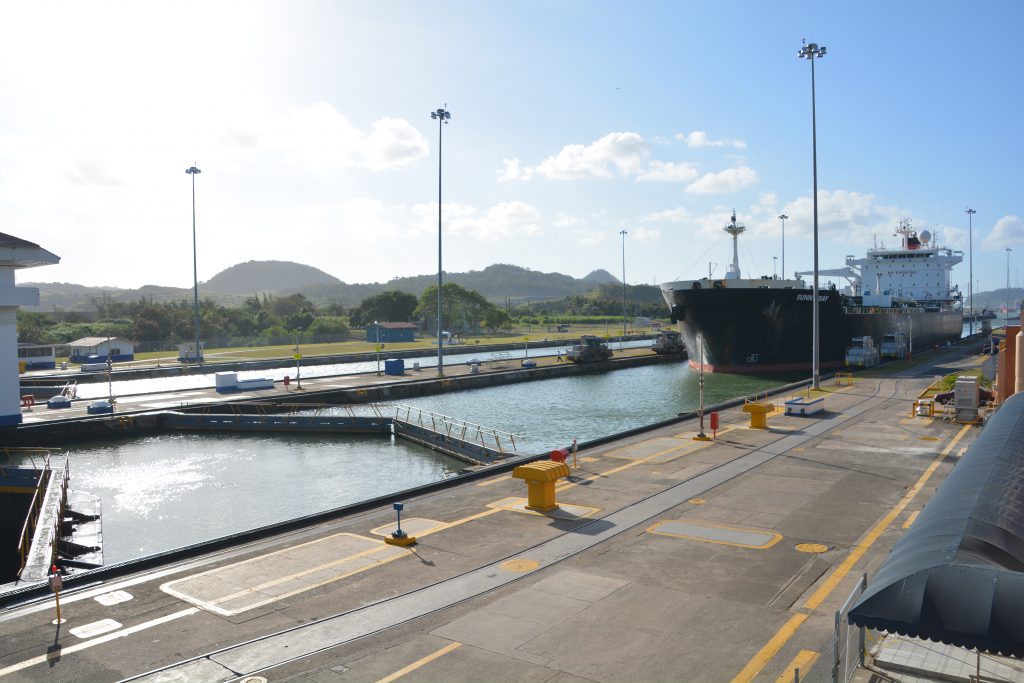
Here comes another one – after one ship passes through the lock fills back up with water and another ship enters to begin the process of dropping step by step down to the Pacific Ocean level
It’s all a little hard to comprehend from afar but watching these ships pass through these huge locks, as Julie and I did, makes you appreciate the enormity of it all – and to think the whole thing is over 100 years old! Exceptionally cool.
In fact, modern cargo ships outgrew the canal many years ago and after a 10 year project the Panamanian government opened a new set of locks in 2016 which can support much larger ships using the latest technology and ensure the Panama Canal will be not just relevant but vital for international commerce for years to come.
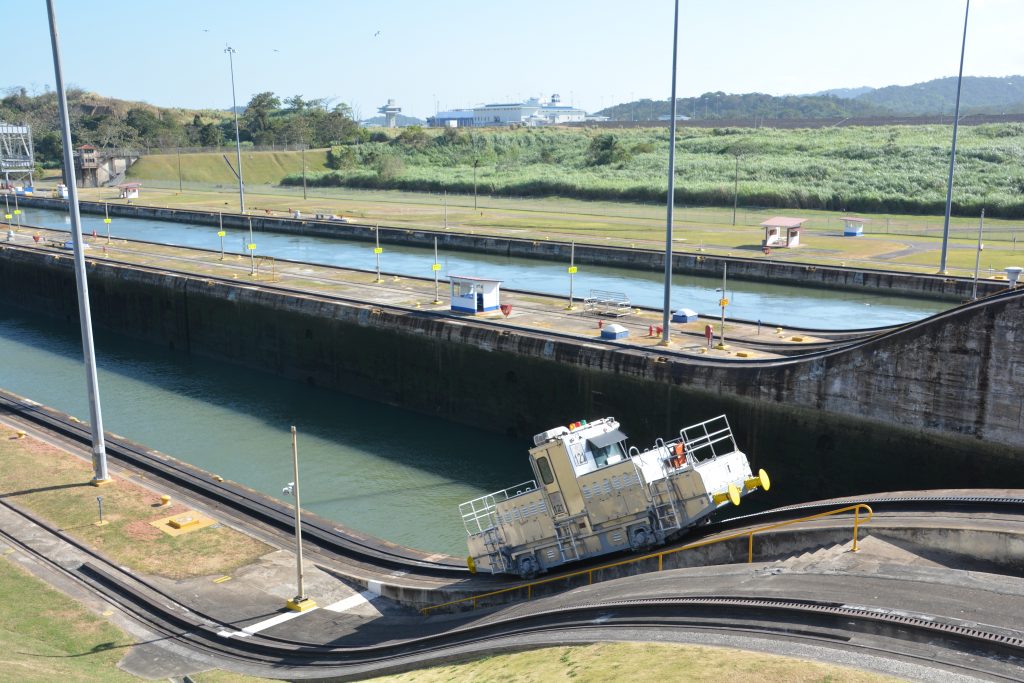
These cool little trains are roped up to the big ships and keep them going slow and straight through the locks
We camped that night in the car park at the Balboa Yacht Club (the Spanish explorer Balboa climbed over the mountains and was the first European to see the Pacific Ocean), as you do, enjoyed drinks on their porch while the sun set and the ships cruised by. A lively Caribbean band kept the dance floor bopping.
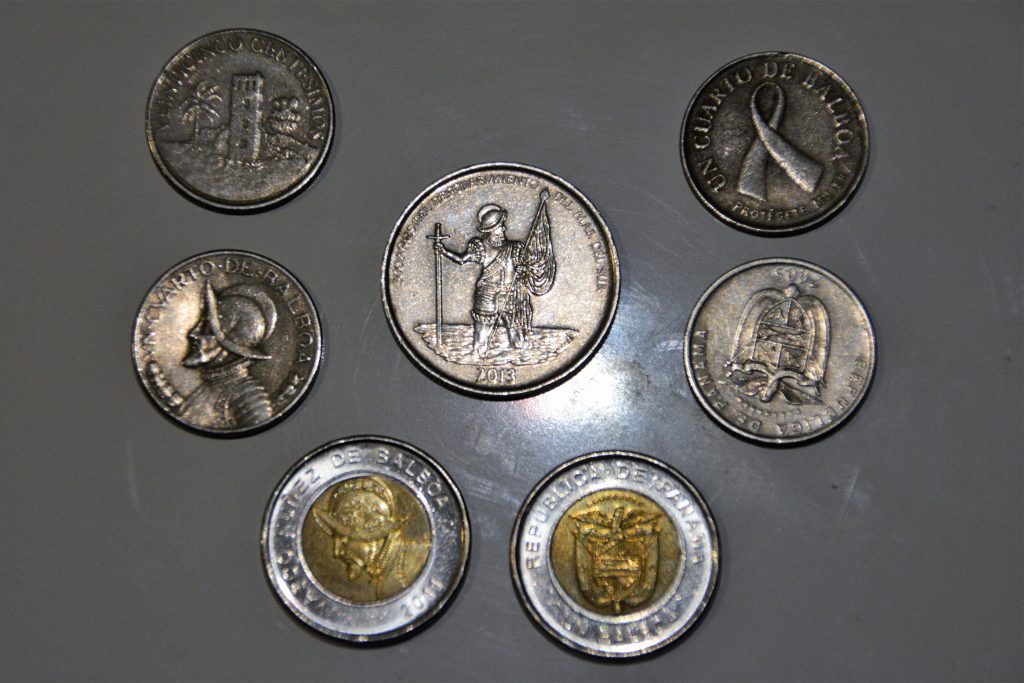
Panama uses the US dollar as its only currency – which it calls the Balboa. But curiously it has invented some of its own coins. The two on the bottom are each one Balboa (one dollar), the large one is half a Balboa (50 cents) and the other ones are a quarter of a Balboa
Shipping a vehicle from Panama to Colombia involves piles of bureaucratic paperwork, endless patience and a bulging wallet. The first step is to get the truck inspected by Panamanian authorities to ensure it has not been reported as lost or stolen. To do this Tramp needed to be inspected at a nondescript signless building in a slum area of town at 7am, along with all the other overlanders and people wishing to import or export vehicles. We completed this task in a remarkably quick one hour. Score one for us.
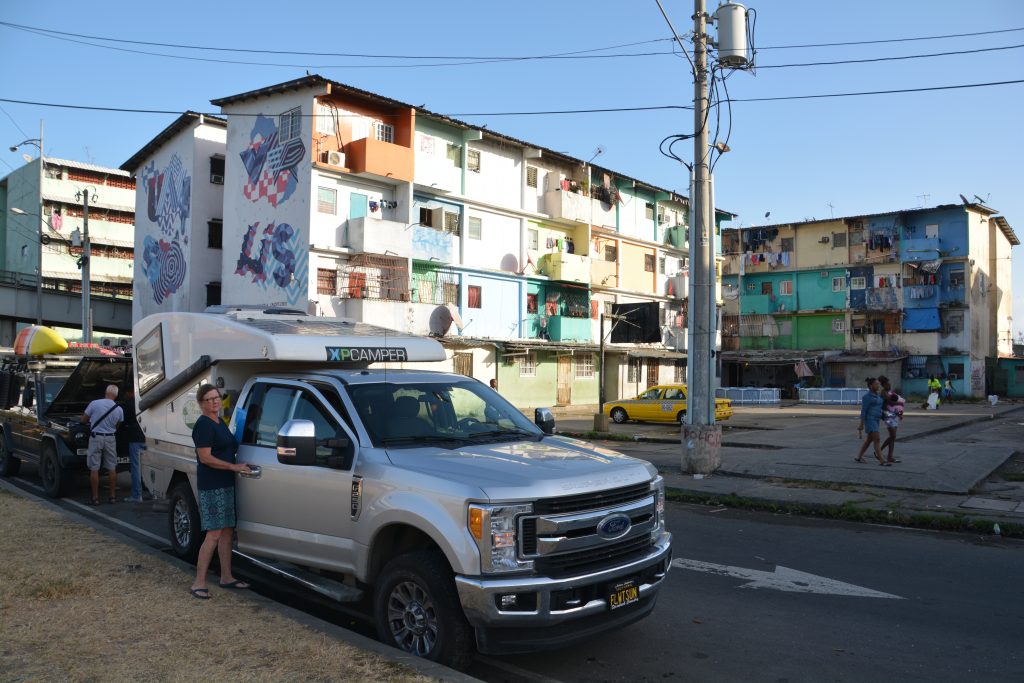
The first step of the vehicle inspection process was in a very dodgy part of town but Julie bravely guarded Tramp while I fluffed around with paperwork and inspectors
Before picking up our completed documents that afternoon we spent the day exploring the old part of Panama City with its beautifully restored buildings (and many that are either beyond restoration or on a long term plan of being restored), including a few churches originally built by the Spanish, all of which have colourful histories of use and misuse.

This building has gone for the uniquely colourful look, never mind it was a fairly average place to live
And always in the distance was modern day Panama City with its gleaming glass skyrises and modern skyline. Panama City is a case of extreme contrast between the dynamic and affluent world of international commerce and the grim realities of living in a poor country with a high population of marginalised people.

This looks good – the Panama City skyline is world class, mainly due to it being an international banking and finance centre
After almost two hours of waiting to pick up our documents we dealt with other administration errands and then became entangled in a horrendous rush-hour traffic mess that burned up the rest of the day. We camped that night at the yacht club again, meeting British couple Marcus and Julie who have been travelling in South America in their super-impressive Iveco truck for two and a half years. Very envious. If you want to read more of this amazing couple and their life permanently on the road go to www.tuckstruck.net.
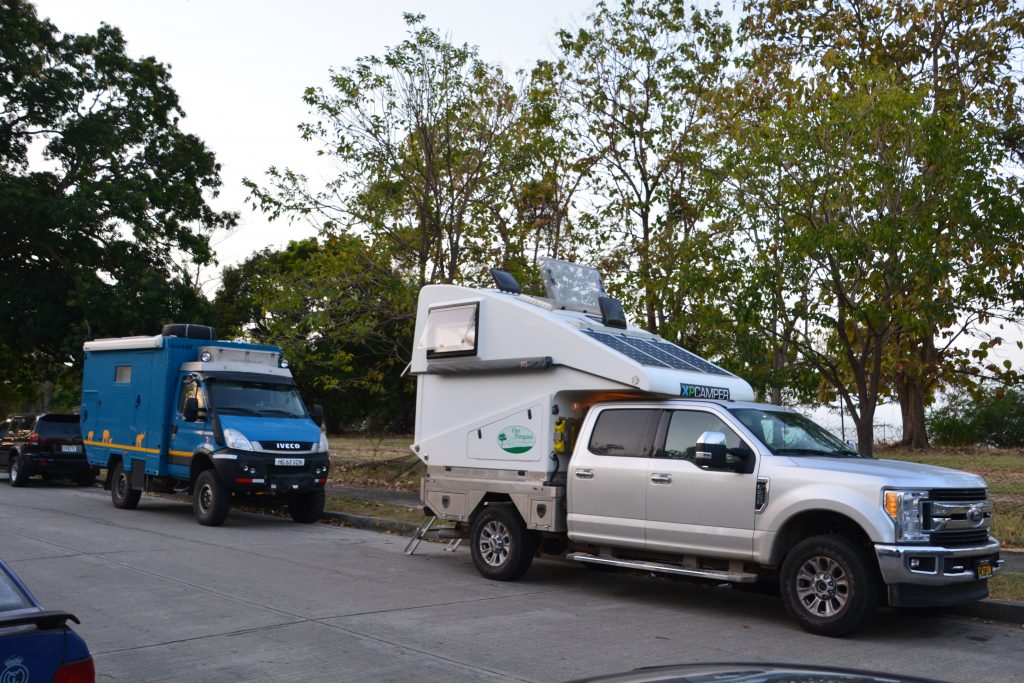
Tramp is classy but check out this Iveco Daily 4×4 expedition truck driven by a British couple who live and travel in it full time
The next day was another full schedule of action items related to shipping Tramp to a new continent. First we had to go into a Citibank office in downtown Panama City – an experience in itself – to pay our huge shipping cost (ouch!), then we battled through excruciating standstill city traffic until we hit the toll way and then about 80 km later arrived at the port of Colon on the Atlantic coast (after escaping the city, a one hour drive from one ocean to another!).

Panama City is a study of extraordinary contrasts – a gleaming shiny skyline and very basic day to day fishing boats
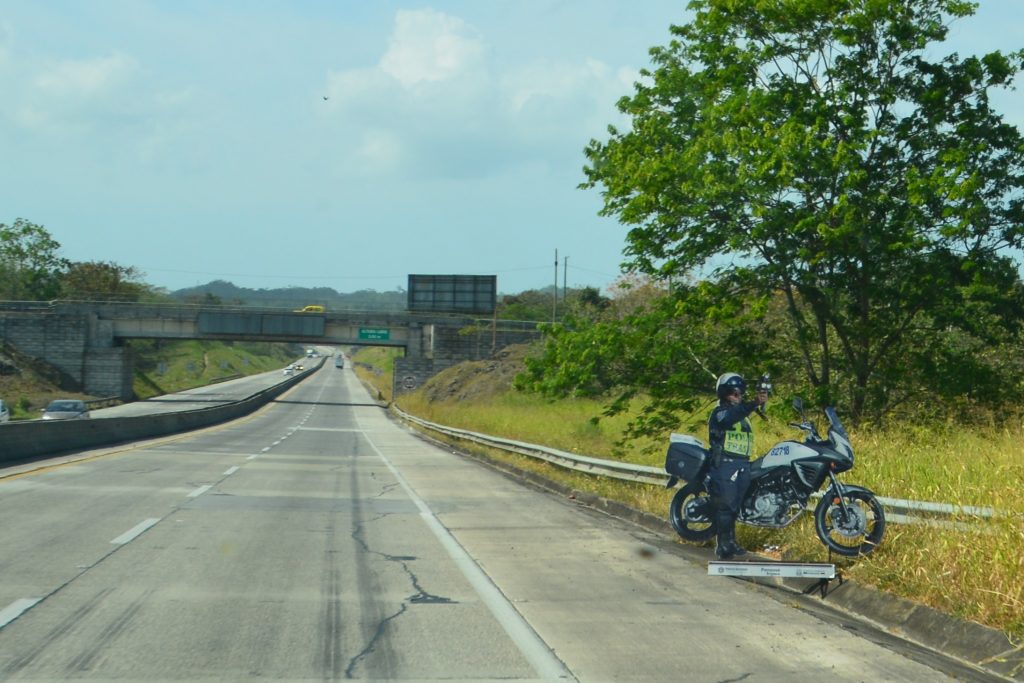
Panama can’t afford highway policemen so they stick up these life-like cardboard cutouts which are supposed to slow you down – really!
The Manzanillo port in Colon is a chaotically bustling series of large old buildings, wide roads, railway tracks, dust and construction everywhere and piles of huge containers. Racing around all of this is an endless stream of large articulated trucks, all carrying loads, moving stuff, racing from one place to another. Amongst all this was Tramp, somewhat lost, a little intimidated and showing the signs of stress from all this fuss. We found the office of our carrier, Seaboard Marine, and got the six copies of our Bill of Lading stamped, signed, punched, copied and stapled. Step one completed, all good so far.
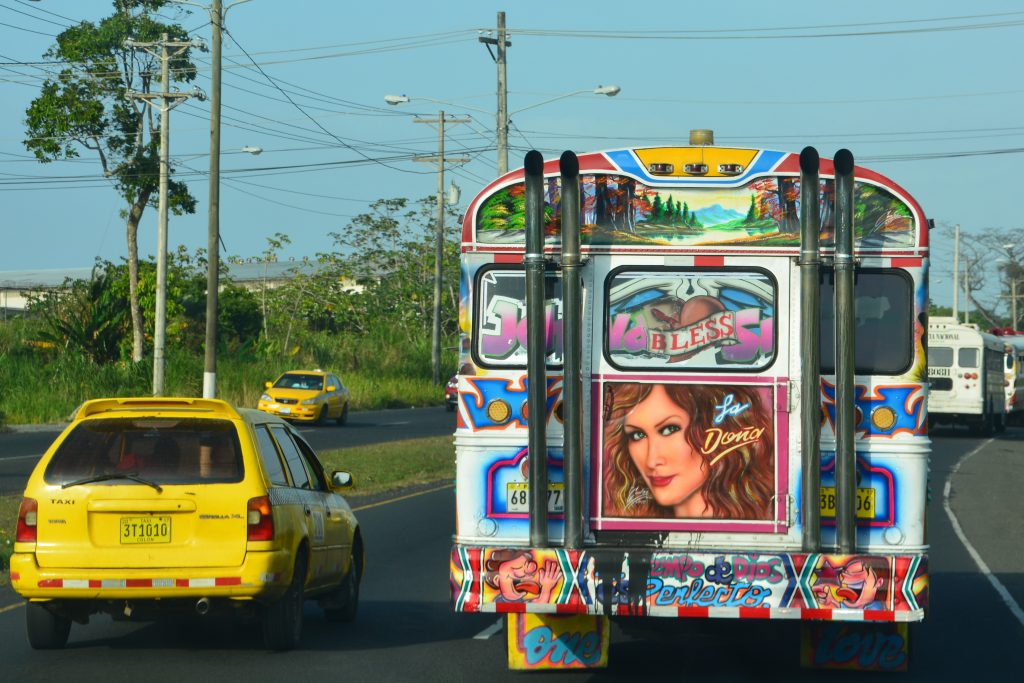
The local buses in Panama rival those in the Philippines for their expressive paint jobs and excessive accessories – especially the chrome appendages
We would come back the next morning to complete the process and leave Tramp behind but for now we drove up into the nearby mountains where there was a pseudo campsite for us to spend the night. The biggest task for us was to repack Tramp so that absolutely nothing was in the cab of the truck (port drivers would move Tramp during the loading and unloading process and it was too risky to leave anything in the open to tempt them). Plus we had to be ready to be away from Tramp for about five days.
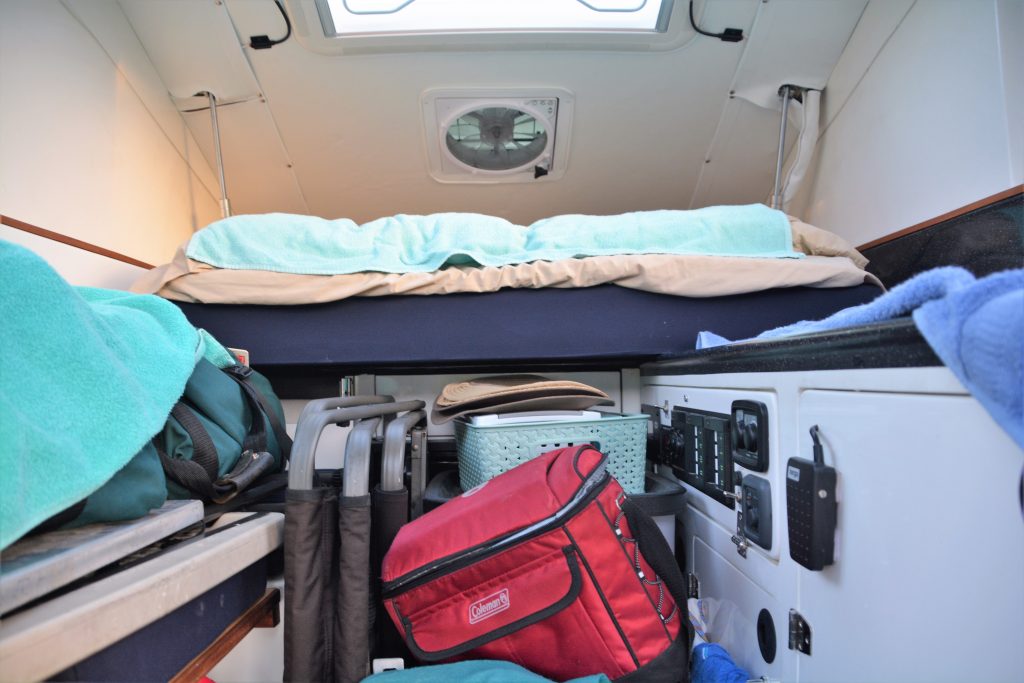
This is a similar view of the inside of Tramp after we packed all the stuff from the cab and side lockers inside the camper (I had to open it for the dog sniffers during the inspection at the port)
The next morning we were down at the port, more stamps, confusion, misleading information and paperwork. By now there was a small group of travellers who were all trying to get their vehicle on our ship and we banded together to help each other with procedure, filling in forms, language problems and moral support. Finally, after the detailed drug inspection and dog sniffing (who smuggles drugs INTO Colombia?) we forlornly watched Tramp get driven off, hopefully to reunite with him in South America.
We jumped in a cab to the local bus station and caught an air-conditioned bus back to Panama City, then another taxi to our hotel near the old part of town. There was a strange feeling about not having Tramp, worrying about him like he was the family pet (hang on, he’s more than a pet!).
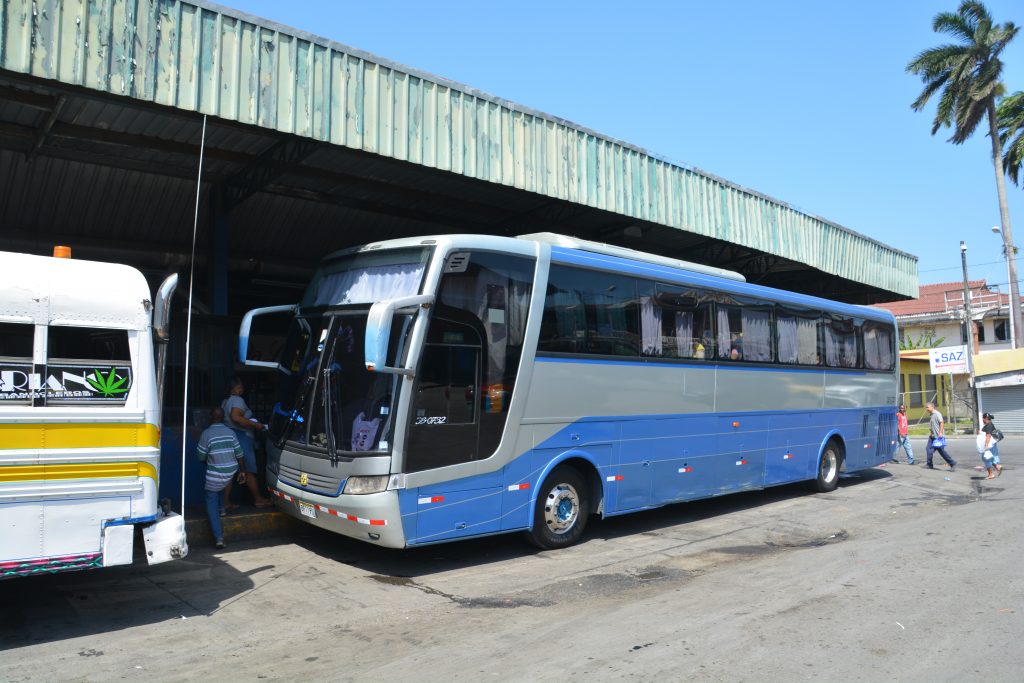
Our new transport – this beaut air conditioned bus took us from the Caribbean Sea back to the Pacific Ocean – its only about an hour’s drive
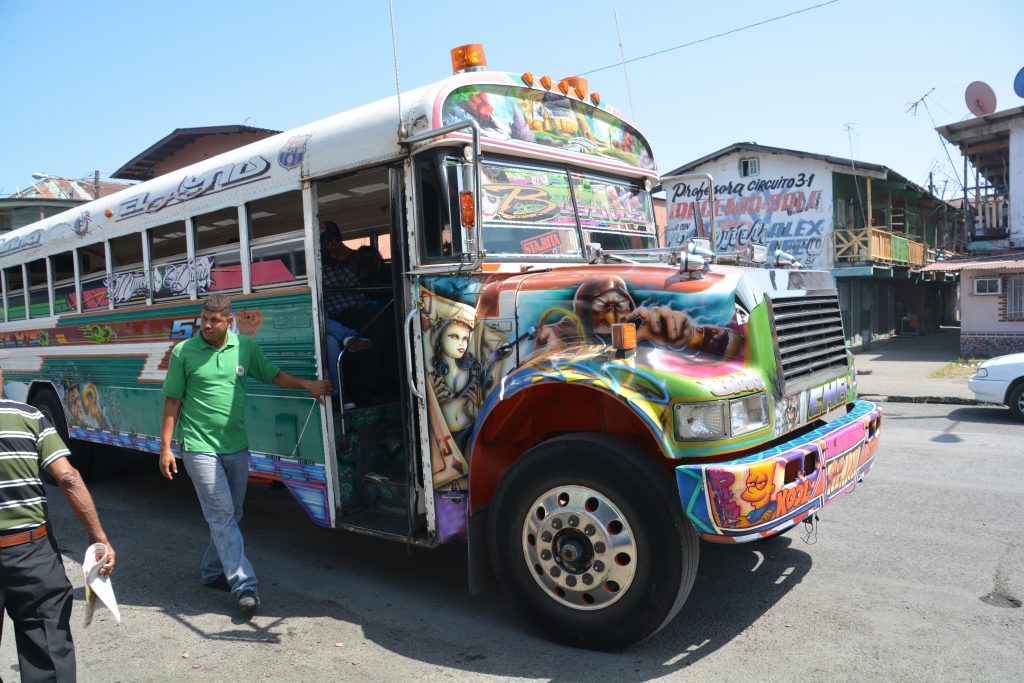
It could have been worse (or better!) – the local buses are much more colourful but don’t have air conditioning and stop at every corner
Our time in Panama and Central America had come to an end. Including Mexico and Cuba we had spent 64 days exploring this part of the world and every one of them had been a ripper. We saw some amazing places, had countless memorable experiences, met friendly and helpful locals, got to know many fellow overlanders and visited nine countries. Putting aside one policeman in Mexico that extracted a bribe from us we did not have a single scary, risky, dangerous or dodgy moment. Central America is a gem of a place to visit if you go in with an open mind and use your travel savvy. We loved it.
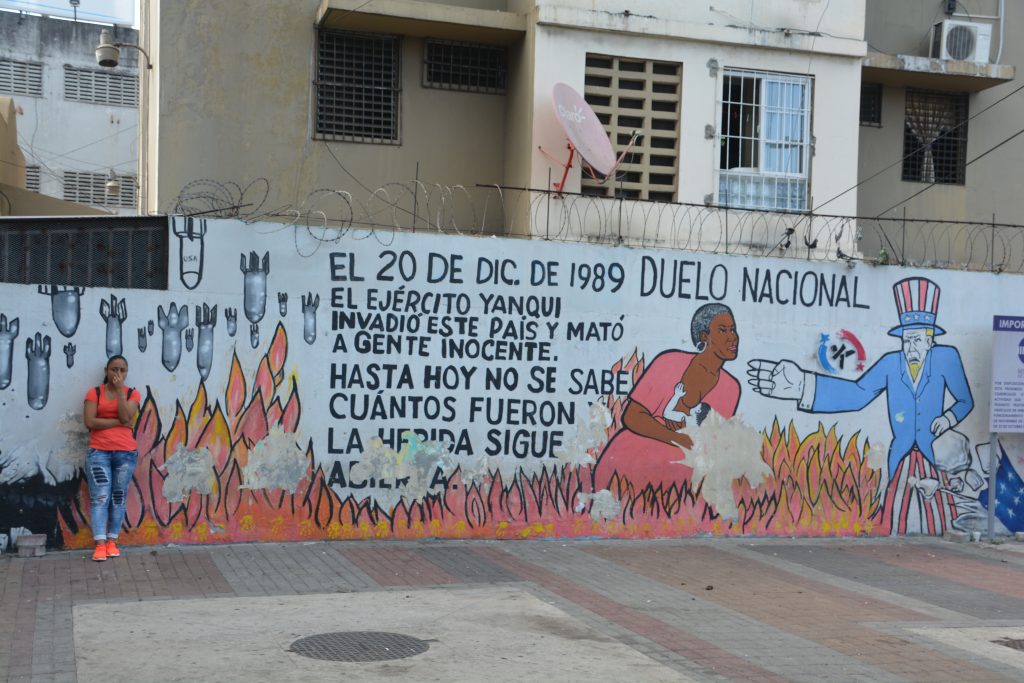
A dose of provocative graffiti from Panama’s turbulent past – roughly translated this says On the 20th of December 1989 the Yankee army invaded this country and killed innocent people. Even today it is not known how many were injured…





Comments
More than just a canal — No Comments
HTML tags allowed in your comment: <a href="" title=""> <abbr title=""> <acronym title=""> <b> <blockquote cite=""> <cite> <code> <del datetime=""> <em> <i> <q cite=""> <s> <strike> <strong>